1995 | OriginalPaper | Buchkapitel
Translation-Invariant De-Noising
verfasst von : R. R. Coifman, D. L. Donoho
Erschienen in: Wavelets and Statistics
Verlag: Springer New York
Enthalten in: Professional Book Archive
Aktivieren Sie unsere intelligente Suche, um passende Fachinhalte oder Patente zu finden.
Wählen Sie Textabschnitte aus um mit Künstlicher Intelligenz passenden Patente zu finden. powered by
Markieren Sie Textabschnitte, um KI-gestützt weitere passende Inhalte zu finden. powered by
De-Noising with the traditional (orthogonal, maximally-decimated) wavelet transform sometimes exhibits visual artifacts; we attribute some of these—for example, Gibbs phenomena in the neighborhood of discontinuities—to the lack of translation invariance of the wavelet basis. One method to suppress such artifacts, termed “cycle spinning” by Coifman, is to “average out” the translation dependence. For a range of shifts, one shifts the data (right or left as the case may be), De-Noises the shifted data, and then unshifts the de-noised data. Doing this for each of a range of shifts, and averaging the several results so obtained, produces a reconstruction subject to far weaker Gibbs phenomena than thresholding based De-Noising using the traditional orthogonal wavelet transform.Cycle-Spinning over the range ofall circulant shifts can be accomplished in ordernlog2(n) time; it is equivalent to de-noising using the undecimated or stationary wavelet transform.Cycle-spinning exhibits benefits outside of wavelet de-noising, for example in cosine packet denoising, where it helps suppress ‘clicks’. It also has a counterpart in frequency domain de-noising, where the goal of translation-invariance is replaced by modulation invariance, and the central shift-De-Noise-unshift operation is replaced by modulate-De-Noise-demodulate.We illustrate these concepts with extensive computational examples; all figures presented here are reproducible using the WaveLab software
